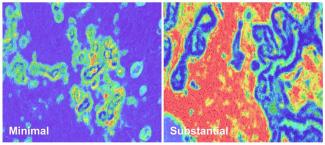2025-05-14 アメリカ国立衛生研究所(NIH)

Slides showing minimal disruption (left) and substantial disruption (right) in breast stromal tissue.NIH/NCI
<関連情報>
- https://www.nih.gov/news-events/news-releases/nih-researchers-discover-tissue-biomarker-may-indicate-higher-risk-aggressive-breast-cancer-development-death
- https://academic.oup.com/jnci/advance-article/doi/10.1093/jnci/djaf070/8128681
侵攻性乳がんの病因と転帰における間質崩壊の役割を解明する Unraveling the role of stromal disruption in aggressive breast cancer etiology and outcomes
Mustapha Abubakar, MD, PhD , Máire A Duggan, MD, FRCPC , Shaoqi Fan, MPH , Ruth M Pfeiffer, PhD , Scott Lawrence, MS , Karun Mutreja, PhD , Alyssa Klein, MS , Hela Koka, MPH, MS , Thomas U Ahearn, PhD, MPH , Jill E Henry, MBA, BA …
NCI: Journal of the National Cancer Institute Published:14 May 2025
DOI:https://doi.org/10.1093/jnci/djaf070
Abstract
Background
Aggressive (typically high-grade) breast cancers (BCs) remain major contributors to BC-related mortality globally. The tissue changes underpinning their etiology and outcomes, however, remain poorly characterized.
Methods
Spatially resolved machine-learning algorithms were used to characterize “stromal disruption” as a morphological metric of reduced/altered extracellular matrix and increased immune, inflammatory, and/or wound response-related processes in normal, benign breast disease (BBD), and invasive hematoxylin and eosin (H&E)-stained breast tissues. Associations of stromal disruption with BC etiologic factors were assessed among 4023 healthy breast tissue donors, its impact on BC incidence was assessed among 974 BBD patients in a nested case–control study, while its prognostic associations were assessed in 4 BC patient cohorts (n = 4223).
Results
Epidemiologic risk factors for aggressive BC, including younger age, multiparity, Black race, obesity, and family history, demonstrated strong associations with increasing stromal disruption in H&E sections prior to tumor development. Substantial stromal disruption in BBD H&E was associated with ∼4-fold increased risk of aggressive (high-grade) BC and ∼3 years shorter latency from BBD to BC diagnosis, independently of BBD histology. Across BC cohorts, stromal disruption in H&E was associated with aggressive (mostly high-grade) tumor phenotypes and with markedly poor prognosis among ER-positive patients, irrespective of histology. The immunobiology of stromal disruption reflected heightened innate (CD68+), adaptive (CD3+CD4+, CD3+CD8+), immunoregulatory (CD3+CD4+FOXP3+), immune escape (PD1+PDL1+), endothelial (CD31+), and myofibroblast (α-SMA+) marker expression.
Conclusion
Our findings highlight the active stromal role in aggressive BC etiology and outcomes, opening possibilities for readily identifying high-risk women across the BC continuum that may benefit from stroma-centric preventative or therapeutic strategies.


